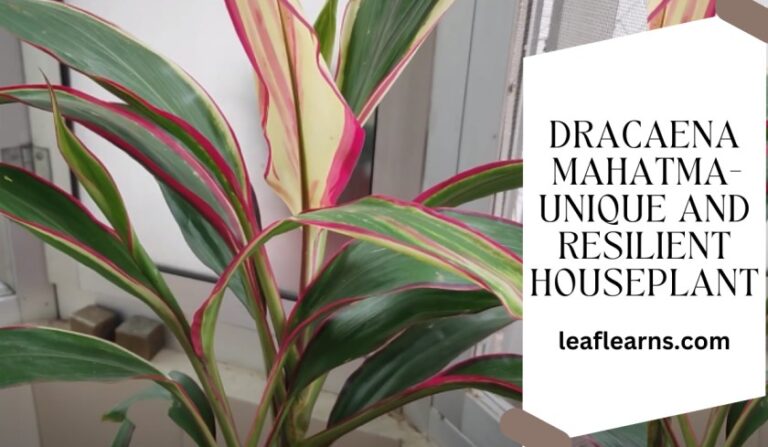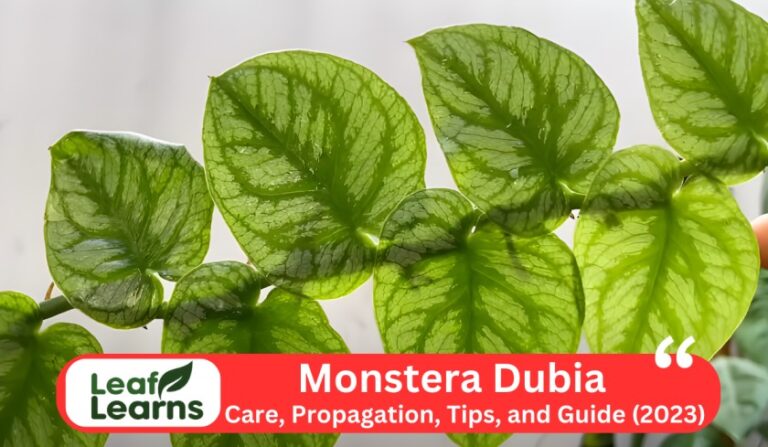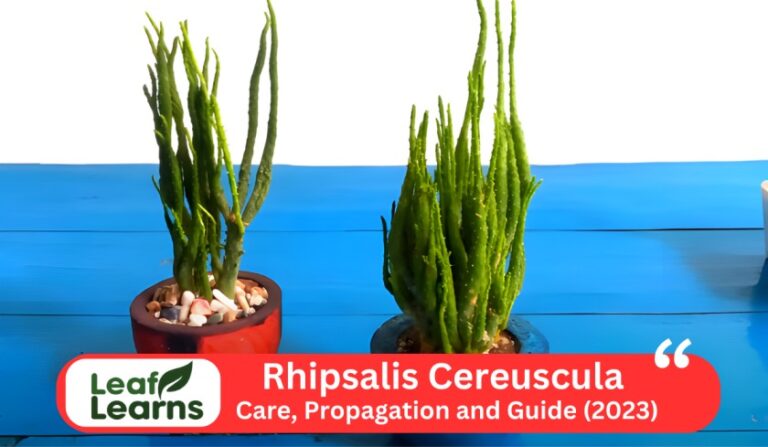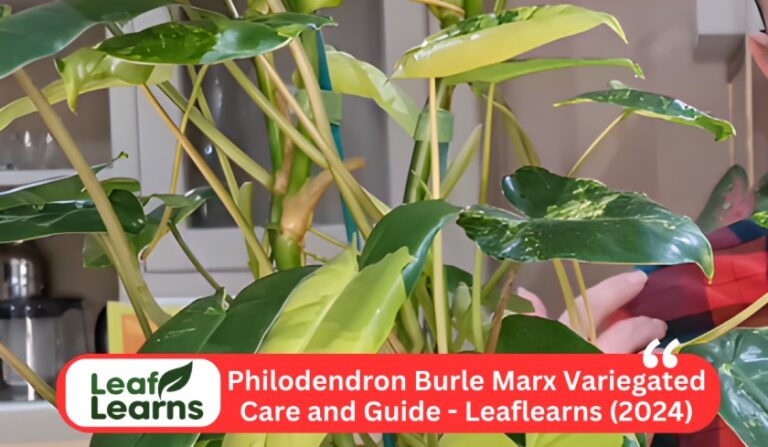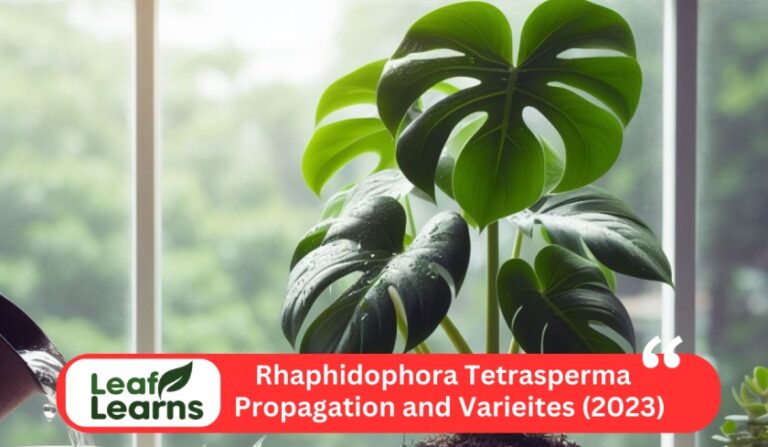Philodendron Imbe – Leaflearns (2024)
Philodendron Imbe is a vigorous and spirited climbing shrub, towering to 2-3 meter in height. Lush and green, it is also a creep to make its roots in the air directly from the trees giving an impression of a tropical land.
This plant from the Araceae family, coming from the rich Brazilian forests, has large green leaves whose colors are bright and a lot of light, but indirect ones will make it grow more efficiently as well as moderate watering is just enough.
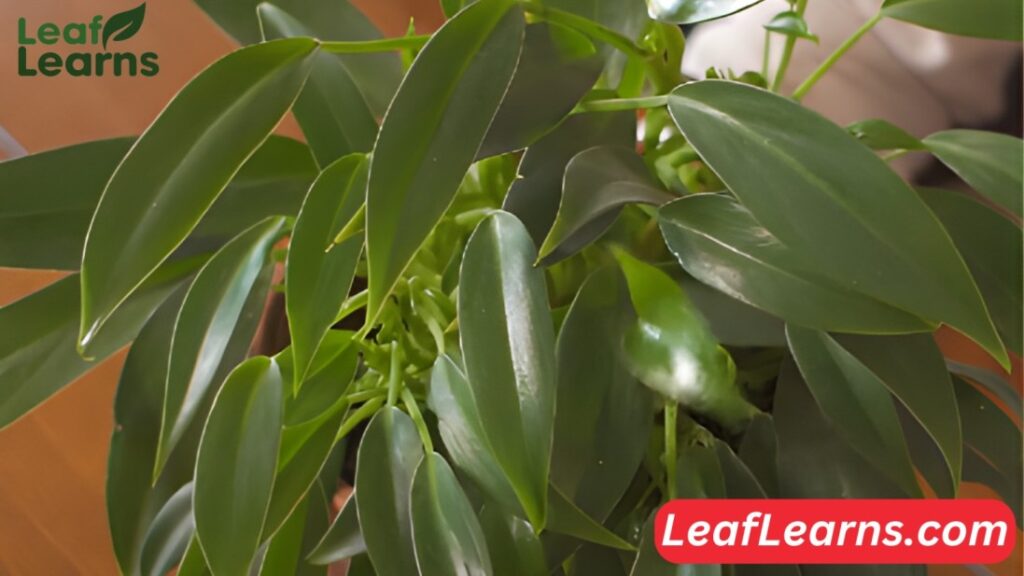
Interestingly, not only do the roots of the plant have utilitarian functions: aerial roots taken from wild found applications in many cases; they are used at the local level for weaving ropes and baskets.
| Common name | Philodendron Burle Marx |
| Scientific Name | Philodendron imbe ‘Burle Marx’ |
| Family | Araceae |
| Origin | Brazil |
| Plant type | Perennial |
| Size | 2 to 3 feet |
| Lifespan | Long-lived |
| Leaf Colour | Green |
| Leaf size | Large |
| Flower | Rarely flowers |
| Light | Bright, indirect |
| Water | Moderate |
| Soil | Well-draining |
| Temperature | 65-80°F (18-27°C) |
| Humidity | High |
| USDA Zone | 10-12 |
| Fertilizer | Balanced |
| Propagation | Stem cuttings |
| Pruning | Trim dead leaves |
| Pests | Mealybugs, spider mites |
| Toxicity | Toxic to pets |
| Uses | Indoor decoration |
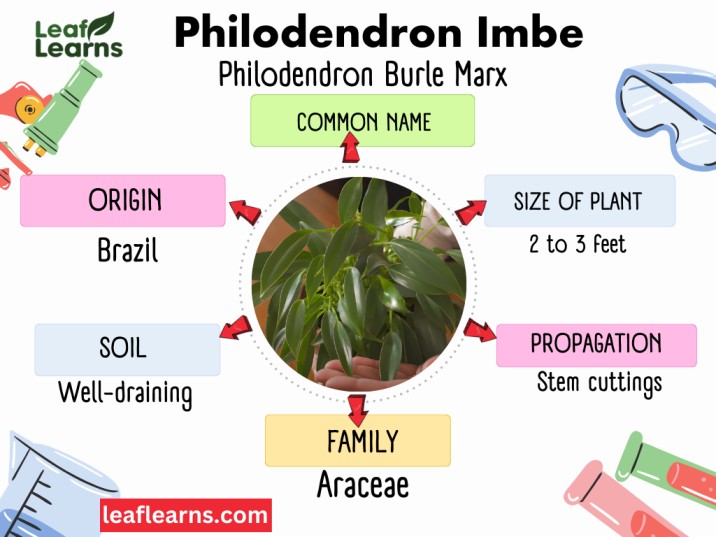
Contents
- 1 Care for philodendron imbe
- 2 How to Propagate philodendron imbe
- 3 Pruning
- 4 Repotting
- 5 Growth and Size
- 6 Appearance
- 7 Fragrance
- 8 Overwintering
- 9 Common Pests and Diseases
- 10 Problems and Solutions
- 11 Toxicity
- 12 Uses
- 13 Exploring the Diversity of Philodendron Species and Varieties
- 14 Nurturing a Green Paradise: The Art and Science of Philodendron Care
- 15 Conclusion
- 16 FAQs
- 16.1 Is Philodendron Imbe rare?
- 16.2 How big does Philodendron Imbe get?
- 16.3 Is Philodendron Imbe a climber?
- 16.4 Is Philodendron Imbe the same as Burle Marx?
- 16.5 Does this plant hibernate in winter?
- 16.6 Should I repot the Imbe plant right after receiving it?
- 16.7 Is Philodendron Imbe toxic for pets?
- 16.8 Is Philodendron imbe a climbing plant?
- 16.9 Can you grow Philodendron Imbe outdoors?
Care for philodendron imbe
Light Requirement
With regard to this plant is suited for well lit conditions with indirect sunlight, making it ideal for indoor settings where there are high amounts of sunlight.
In summer, it likes dodgy shades to prevent its leaves from being scorched by the sun. It helps to be near windows in winter to take advantage of the most possible sunlight.
Ensuring that it remains in its regular light conditions allows spring and fall to remain steady in their growth. With its moderate the Philodendrons Imbe adds spanning functions without crowding smaller areas.
Water Requirements
Also, Philodendron-Imbe is a product of many plants found in tropical climates, and it grows best under moderate watering that is suitable for beginners and veterans alike.
As it gets hotter and hotter during summer, be sure to water your Imbe when the first 1-inch layer of soil feels dry.
However, when growth is at its optimum, it’s important that the soil is consistently moist but never completely saturated; this usually requires watering anywhere between once to twice a week.
During winter season when days are shortening and growth is slowed, wait till the upper 2 to 3 inches of soil are dry before watering again or when the rate of growth is low.
Reduce frequency of watering to prevent waterlogging. Spring and fall seasons should be modified to adjust watering, obtaining slightly drier soil space between the next watering.
Soil Requirement
Well-draining soil is a major condition for the success of this plant since root rot can easily attack it if the soil has poor drainage.
It should also have a moist soil, during summer, but not very wet; mimicking its tropical environment.
With respect to the winter period, slow down on watering since soil would be waterlogged that is in accordance with its dormant state.
In spring and fall keep to the same watering to ensure accelerated growth. Ideally, a combination of the three makes up the perfect soil; peat moss, perlite and compost for maximum nutrition and drainage.
Temperature Requirement
Philodendron-Imbe, which is a tropical plant with an ideal temperatures range between 65°F to 80°F (18°C to 27°C).
In summer, It is able to cope with hotter warm days and can stand temperatures up to 85°F (29°C) so long as humidity is good.
It appreciates warmer conditions a bit more but needs to be protected from the direct sun.
During the winter, on the days when the temperatures decrease and the length of days is shortening, make sure to maintain your Imbe at 65-70 °F (18-21 °C).
Humidity Requirement
It is of great importance to preserve the humidity in favourable hours for this plant.
When the summertime comes, as the temperatures spike and your Imbe starts reaching for the heaven’s, 60 – 70% humidity, yet daily shower in a rainforest.
During the winter season, days get shortened and the growth rate declines to a considerable extent, keep the humidity levels between 50-60 per cent to prevent these plants from drying out in the winter when indoor heating dries the air, a tray of water kept near or the grouping of these plants with others can help in retaining moisture.
Monitoring and adjusting in spring and fall keep the humidity relative stableand enhance healthy growth under the conditions of preventing problems such as leaf browning.
Philodendron-Imbe, which grows to great heights with a heavy foliage, is suited for humid environments where the humidity varies between 60-80%.
Fertilizer Requirement
If you want to thrive your Philodendron, it is understanding the fertilizer needs of the plant throughout its growing season is significant.

Feed your plant with a balanced fertilizer every 2-4 weeks during the active growing season of spring and summer as the seasons to support its optimum growth.
When autumn is coming and growth rate dies down change fertilizing to one time of every 4-6 weeks.
Only apply fertilizer during the summer months, when growth is significant; withhold completely or apply a diluted solution every 6-8 weeks in winter, to prevent accumulation of nutrients.
Potting Requirement
Philodendron-Imbe requires a simple but effective potting routine to ensure that it survives all year.
In summer, the pot should be drained effectively to avoid waterlogging and keep a similar pattern of watering.
In winter, temperatures drop and you have to decrease the frequency of watering to prevent root rot but should not allow the humidity levels to drop by misting the plant every once in a while.
Spring and fall should be monitored closely by soil moisture to ensure watering is adjusted as necessary.
How to Propagate philodendron imbe
Stem Cuttings
This tried-and-true method is perfect for beginners and seasoned propagators alike. Here’s how to turn one Imbe into many:
- Choose a healthy stem: Choose a strong stem that is at least 2-3 nodes ( those tiny bumps where leaves appear). Cut just below a node using a sterile knife and make a clean cut.
- Leaf it up (or not): Although it is possible to leave several top leaves on the cutting, some removal may increase growth speed of root. Simply remember that every retained leave works against you in terms of energy spent on maintaining it, so don’t go over the top.
- Either place it into a glass of water (and change it from time to time), or pot it in a good potting medium with the right drainage. Get the node into the ground.
- Warmth and humidity: Let your cutting find a comfortable place under full, indirect light and temperatures no less than 65 to 75°F. But the consistency of humidity is vital, so if you’re going to develop a mini greenhouse, use a humidifier, pebble tray or clear plastic bag.
- Patience is a virtue: Since rooting may require a couple of weeks to a month or so, patience is needed on your part. It is best to mist the leaf surface often and the soil should be kept moist but not soggy. If you notice any new growth, then you’ve got a fetus Imbe on the way.
Air Layering
This method is a bit more advanced but lets you propagate directly on the mother plant. Perfect for creating bushier Imbe or if you’re short on space!
- Choose your target: Choose the selected plant with a healthy stem and mature aerial root. On the stem, cut in a slanting manner after half of the way from the root.
- Moisturize and wrap: Rooting hormone can (may) be applied onto the cut and wrapped with moist sphagnum moss. Wrap the moss either in plastic wrap or cellophane, right at the root tip.
- Misting is key: Make sure you keep the moss wet at all times by misting it periodically. These roots grow slowly and you might see the end after few weeks – those are little white bumps.
- Sever ties and pot up: When the roots are reasonably developed, cut through the stem just below the moss ball and pot up your new Imbe in a moisture-permeable soil.
Leaf Cuttings
- There is a less common breeding technique and that is possible by some luck and of course the right variety of Imbe as the Philodendron-Imbe ‘Burle Marx’.
- Choose a mature leaf: Take a leaf with a petiole that is not damaged and healthy. Trim the petiole in a very close proximity to the stem leaving a tiny amount of it attached.
- Water or soil?: If the petiole-down, place into water in a glass or repot it up in a well-drained mix. Condition the petiole with soil or water.
- Warmth and patience: As in the case of stem cuttings, give them bright but indirect light, relatively high temperatures, and maintain the stable humidity level. Several weeks old, the petiole base may develop as new plantlets. Once they start setting roots and leaves, divide them carefully by potting each up separately.
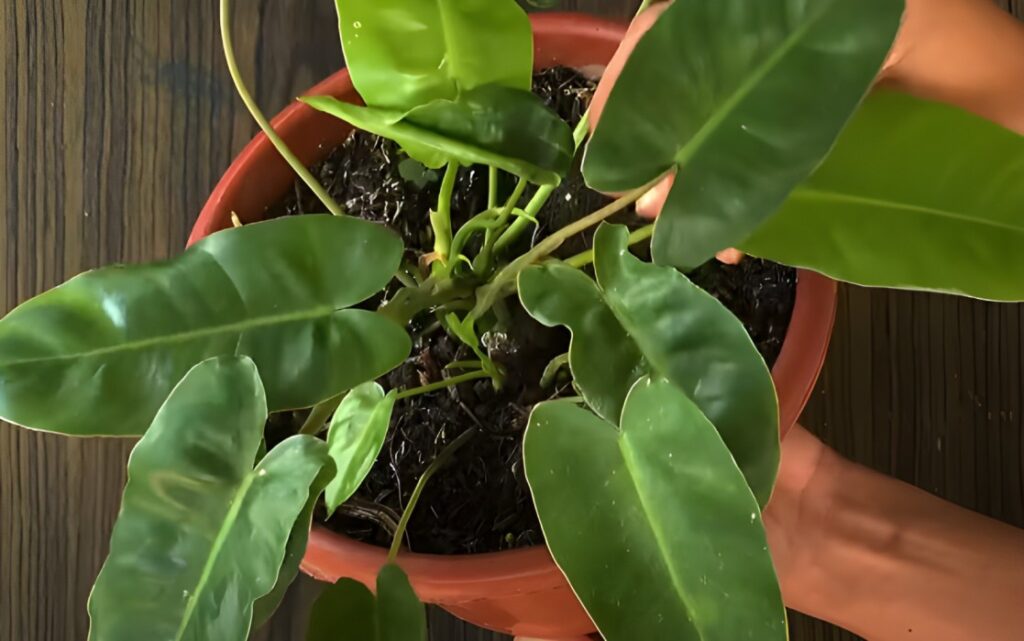
Pruning
Pruning is important in ensuring the healthy looking of this plant. Cut off dead leaves and yellowing ones to foster new development of green leaves and stop epiphyte formation.
To make very clean cuts near the base of the stem, use a pair of very clean and sharp scissors.
Furthermore, prune out unsuitable leggy and crowed growth to encourage a bushier and more compact plant.
Repotting
It’s critical to repot your Philodendron-Imbe to give it new nutrients and plenty of room to flourish. To avoid waterlogging, choose a pot that is one size larger than its present container and make sure it has drainage holes.
After carefully removing the plant from its existing pot and loosening its roots, transfer it to the new pot filled with fresh potting mix. After giving it a thorough watering, put it somewhere with indirect light.
You may maintain the health and blooming of your Philodendron-Imbe by repotting it every 1-2 years, ideally in the spring.
Growth and Size
When it comes to growth, the Philodendron, often referred to as Imbé, doesn’t play around. During its peak growing season (spring and summer), this tropical vine may grow up to 2-4 inches per week
and can easily reach 5 metres or more outside in conditions that are suitable for it.
Even though the Imbe has the potential to grow into a massive tree, with little training and pruning, its interior growth may be managed.
You may make a living green curtain, teach your Imbe to climb a moss pole or trellis, or just nip back new growth to keep it compact and bushy.
Flower Power (or Not):
Fans of flowers, get over it! The Imbe doesn’t usually bloom inside, in contrast to other of its Philodendron cousins.
But in its native environment, given the correct circumstances, it can yield a creamy-white spadix, which is a kind of flower, encircled by a green spathe, which is a modified leaf.
Foliage
The Imbe’s lush foliage is what really steals the show. Picture up to 60 cm long, heart-shaped, elongated leaves that fall like green curtains.
These leaves give your room a hint of textural curiosity with their striking glossy texture and noticeable veins.
Appearance
The Philodendron-Imbe has large and shiny green leaves, which flow outward so elegantly that it will give any interior a touch of tropical charm.
It stands out from the crowd owing to its vibrant, flamboyant growth that makes it the focal point in home gardens and interior décor.
Philodendron-Imbe emerges with dense foliage and wide-spreading vines that create an abundant, green environment similar to the rainforest habitat it originated from.
Fragrance
Philodendron is not known for its fragrance but it emits a very light fragrance which is somewhat earthy, thereby enhancing its natural beauty.
Considering it grows inside, its introduction to the living space can be quite refreshing and bring a feeling of freshness inside with a clean aroma that not only improves the overall quality of air but also adds vivacity to the household.
Overwintering
It is imperative to give Philodendrons Imbe the necessary attention during the winter season since this can affect its development and health.
Because this tropical plant can withstand temperatures marginally cooler than those in the tropics, you should place it in a warm, draft-free location to avoid damage caused by cold drafts.
Besides, a lower watering regime in the winter and avoidance of overwatering are vital to prevent root rot as well.
Common Pests and Diseases
Pests: Resiliency as demonstrated by Philodendron-Imbe notwithstanding, this plant is vulnerable to common pests such as:
- Mealybugs: These wee creatures are cotton-like, and they bunch up on the underside of leaf, by feeding off it and stunting growth.
- Spider Mites: These spiders weave webs on the plant, they suck sap from the foliage making them yellowish and give them wrinkles.
- Scale Insects: The stems and leaves of the plant are also a target for these pests, which draw off its life-sap.
Diseases: However, this plant is generally immune to diseases, but sometimes problematic cases may occur like:
- Root Rot: If water is excessive, the plant may develop root rot and its roots will be rotten which greatly affects its health.
- Leaf Spot: During the development of such infections fungal diseases can cause dark spotting or lesions on the leaves, making it less appealing to look at.
- Bacterial Blight: The pathogens are causing infection on the leaves in the form of water-soaked lesions which may spread if not controlled immediately.
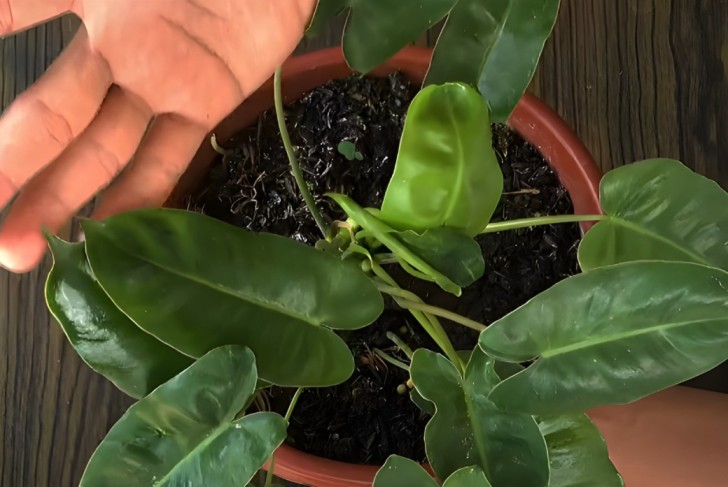
Problems and Solutions
Problem: Yellowing Leaves
Solution: To avoid root rot, make sure the drainage is adequate and change how often you water.
Problem: Pests like Mealybugs
Solution: To gently remove bugs, use neem oil or a mild dishwashing solution, being sure to cover both sides of the leaves.
Problem: Overwatering
Solution: In between waterings, let the soil dry out and make sure the container has drainage holes.
Problem: Insufficient Light
Solution: Relocate the plant to an area that receives more indirect sunlight, or think about adding more artificial lighting.
Problem: Brown Leaf Tips
Solution: By spraying the leaves or putting a humidifier close by, you may raise the humidity levels.
Problem: Pot-bound Roots
Solution: Move the plant to a bigger pot and fill it with new soil that drains properly.
Problem: Lack of Nutrients
Solution: During the growth season, feed the plant every four to six weeks with a balanced liquid fertiliser that has been diluted to half strength.
Problem: Wilting or Drooping Leaves
Solution: Verify the moisture content of the soil and modify the amount of water applied to the plant so as not to submerge or overwater it.
Toxicity
This plant is toxic to humans. Although Philodendron-Imbe gives houses a touch of greenery, if consumed, the calcium oxalate crystals in its leaves can cause discomfort. It’s imperative to keep them out of the reach of curious kids in particular.
This plant is toxic to Cats and Dogs and cause symptoms including vomiting, drooling, and trouble swallowing. In the event of ingestion, prompt veterinarian care is important.
Uses
- Indoor Decoration: With its huge, vivid green leaves, Philodendrons Imbe enhances aesthetics and lends a sense of tropical elegance to any interior area.
- Air Purification: By removing toxins and impurities from indoor air, this hardy plant contributes to a better living space.
- The utilization of Philodendron-Imbe in interior design schemes is known to amplify biophilic features, which in turn promote well-being and a sense of connectedness to nature.
- Stress Reduction: The addition of greenery, such as Philodendron-Imbe, to home and business spaces has been shown to lower stress levels and promote relaxation.
- Natural Décor Accent: Philodendron-Imbe is a multipurpose and aesthetically pleasing natural décor accent that enhances the atmosphere of any environment, whether it is put in the living room, bedroom, or workplace.
Exploring the Diversity of Philodendron Species and Varieties
In the world of philodendrons, enthusiasts and cultivators often find themselves navigating through a diverse array of species and varieties, each with its own unique characteristics and care requirements.
From the intriguing philodendrons imbe to the vibrant philodendron variegated, the quest to understand and cultivate these plants extends beyond mere horticulture; it becomes a journey of exploration and appreciation for the intricacies of nature’s designs.
Whether delving into the common names of these philodendrons, such as the illustrious philodendron-imbe queen or the captivating philodendron-imbe rubra, or seeking guidance on propagation techniques through informative platforms like philodendron-imbe youtube channels, enthusiasts immerse themselves in a world where each variety holds its own allure and mystique.
Nurturing a Green Paradise: The Art and Science of Philodendron Care
However, amidst the fascination with philodendron species and their variations, caretakers must also uphold a vigilant stance on proper maintenance and cultivation practices.
Care routines extend beyond mere watering and sunlight exposure, as demonstrated by the meticulous attention to detail in philodendron care and maintenance clusters.
Here, the journey involves not only nurturing the plants themselves but also exploring innovative support ideas and troubleshooting common issues like philodendron hope problems.
Moreover, discussions on comparative analyses between different varieties, such as the contrast between philodendron imbe vs burle marx or the nuanced care instructions for philodendron wend imbe variegated, underscore the depth of knowledge required to thrive in the realm of philodendron cultivation.
Conclusion
In conclusion, caring for Philodendron-Imbe requires attention to its specific needs across various factors. Providing adequate light, ensuring well-draining soil, and maintaining appropriate humidity levels are crucial for its thriving growth.
Understanding its watering requirements throughout the seasons, adjusting fertilization accordingly, and pruning to manage its size and shape are essential practices for nurturing a healthy plant.
While it may not bloom indoors, its lush foliage and subtle fragrance contribute to its appeal as an indoor decorative plant. Vigilance against common pests and diseases, along with prompt solutions to potential problems, helps in maintaining its vitality.
FAQs
Is Philodendron Imbe rare?
Though it’s not as uncommon as some other philodendrons like the Heartleaf or Xanadu, Philodendron Imbe is nonetheless regarded unusual. To locate it, you would have to go to specialist nurseries or internet stores.
How big does Philodendron Imbe get?
In the right circumstances, mature Philodendron-Imbe plants may grow up to 16 feet (5 metres) tall, with many feet of trailing tendrils. It takes them some time to attain that size, though, due to their sluggish development rate.
Is Philodendron Imbe a climber?
This plant is inherently a climber, yes. Its aerial roots easily cling to trellises, moss poles, or other supports, enabling it to grow higher and provide an amazing cascade effect.
Is Philodendron Imbe the same as Burle Marx?
No, Philodendron Burle Marx and Philodendron-Imbe are not the same. Burle Marx has textured, somewhat crinkled leaves, whilst Imbe has larger, elongated leaves that are smoother and glossier.
Does this plant hibernate in winter?
Although Philodendron Imbe doesn’t actually hibernate in the winter, the fewer days and lower temperatures may cause it to develop more slowly. It doesn’t, however, need any further attention at this moment.
Should I repot the Imbe plant right after receiving it?
Repotting a plant right away after purchase is usually not advised. Repotting increases the stress that comes with the environment shift. If you need to repot the plant, let it a week or two to become used to your house.
Is Philodendron Imbe toxic for pets?
Like the majority of philodendrons, philodendron Imbe is regarded as somewhat harmful to pets if consumed. Poisoning symptoms might include upset stomach, diarrhoea, and vomiting. Keep it out of the reach of kids and curious pets.
Is Philodendron imbe a climbing plant?
Indeed, as was already indicated, Philodendron Imbe loves to have something to hold onto as it develops since it is a natural climber.
Can you grow Philodendron Imbe outdoors?
In warm locations when the temperature is continuously over 55°F (13°C) and there is bright, indirect light, Philodendron Imbe may be cultivated outdoors. But if the temperature falls below that, bring it inside because it is not frost-tolerant.

